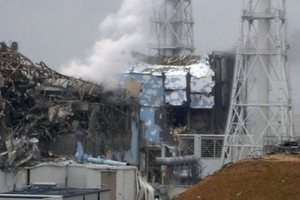
Neutron beam observed 13 times
Kyodo News
Tokyo Electric Power Co. said Wednesday it has observed a neutron beam, a kind of radioactive ray, 13 times on the premises of its crippled Fukushima No. 1 nuclear plant.
Tepco said the neutron beam measured about 1.5 km southwest of the plant's Nos. 1 and 2 reactors over three days from March 13 and is equivalent to 0.01 to 0.02 microsieverts per hour. This is not a dangerous level of radiation, it added.
The utility said it will also measure uranium and plutonium, which could emit a neutron beam.
In the 1999 criticality accident at a nuclear fuel processing plant run by JCO Co. in Tokai, Ibaraki Prefecture, uranium broke apart continually in nuclear fission, causing a massive amount of neutron beams.
In the latest case at the Fukushima No. 1 plant, a criticality accident has yet to happen.
But the measured neutron beam may be evidence that uranium and plutonium leaked from the plant's nuclear reactors and spent nuclear fuel have discharged a small amount of neutron beams via fission.


Because free neutrons are unstable, they can be obtained only from nuclear disintegrations, nuclear reactions, and high-energy reactions (such as in cosmic radiation showers or accelerator collisions). Free neutron beams are obtained from neutron sources by neutron transport. For access to intense neutron sources, researchers must go to specialist facilities, such as the ISIS facility in the United Kingdom, which is currently the world's most intense pulsed neutron and muon source.[citation needed]
The neutron's lack of total electric charge makes it difficult to steer or accelerate them. Charged particles can be accelerated, decelerated, or deflected by electric or magnetic fields. These methods have little effect on neutrons beyond a small effect of an inhomogeneous magnetic field because of the neutron's magnetic moment. Neutrons can be controlled by methods that include moderation, reflection and velocity selection.
Exposure to free neutrons can be hazardous, since the interaction of neutrons with molecules in the body can cause disruption to molecules and atoms, and can also cause reactions which give rise to other forms of radiation (such as protons). The normal precautions of radiation protection apply: avoid exposure, stay as far from the source as possible, and keep exposure time to a minimum. Some particular thought must be given to how to protect from neutron exposure, however. For other types of radiation, e.g. alpha particles, beta particles, or gamma rays, material of a high atomic number and with high density make for good shielding; frequently lead is used. However, this approach will not work with neutrons, since the absorption of neutrons does not increase straightforwardly with atomic number, as it does with alpha, beta, and gamma radiation. Instead one needs to look at the particular interactions neutrons have with matter (see the section on detection above). For example, hydrogen rich materials are often used to shield against neutrons, since ordinary hydrogen both scatters and slows neutrons. This often means that simple concrete blocks or even paraffin-loaded plastic blocks afford better protection from neutrons than do far more dense materials. After slowing, neutrons may then be absorbed with an isotope which has high affinity for slow neutrons without causing secondary capture-radiation, such as lithium-6.
Hydrogen-rich ordinary water affects neutron absorption in nuclear fission reactors: usually neutrons are so strongly absorbed by normal water that fuel-enrichment with fissionable isotope is required. The deuterium in heavy water has a very much lower absorption affinity for neutrons than does protium (normal light hydrogen). Deuterium is therefore used in CANDU-type reactors, in order to slow (moderate) neutron velocity, to increase the probability of nuclear fission compared to neutron capture.
